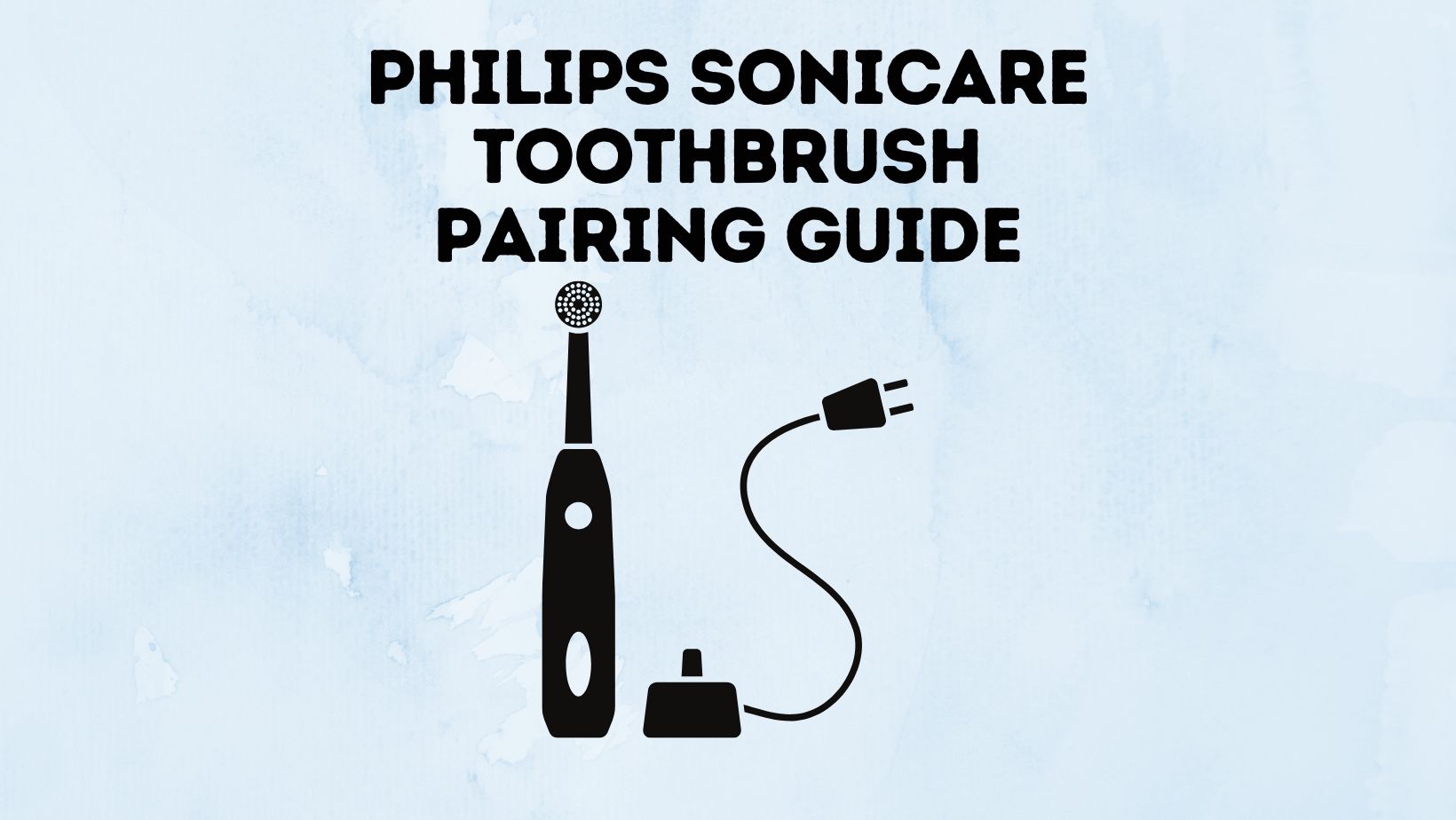
The Sonicare toothbrush is a popular brand of electric toothbrushes manufactured by Philips. It utilizes high-frequency sonic vibrations to provide a thorough and effective cleaning experience for your teeth and gums.
Wondering, How to pair Sonicare ToothBrush? Pairing a Sonicare toothbrush typically refers to connecting it to a companion app or a Bluetooth-enabled device to access additional features or track your brushing habits. Not all Sonicare models have Bluetooth connectivity or require pairing, so it’s important to check the specific features of your toothbrush model.
Table of Contents
9 Easy Steps To Pair Sonicare ToothBrush
To pair a Sonicare toothbrush with a companion app or device, follow these general steps:
- Download the companion app: If your Sonicare toothbrush is compatible with a companion app, download the app from the respective app store onto your smartphone or tablet.
- Enable Bluetooth: Make sure the Bluetooth function is enabled on your device. You can usually do this through the settings menu of your device.
- Power on the toothbrush: Turn on your Sonicare toothbrush by pressing the power button. The location of the power button may vary depending on the model.
- Put the toothbrush in pairing mode: Look for the pairing button on the toothbrush handle. Press and hold the pairing button until the pairing light starts flashing or a pairing symbol appears on the toothbrush handle.
- Open the companion app: Launch the companion app on your device.
- Follow the on-screen instructions: The app will guide you through the pairing process. It may ask you to select your toothbrush model or search for available devices.
- Select your toothbrush: Once the app detects your Sonicare toothbrush, select it from the list of available devices or confirm the connection.
- Complete the pairing: Follow any further on-screen prompts to complete the pairing process, which may involve entering a pairing code or confirming the connection.
- Enjoy the additional features: Once the pairing is successful, you can access features such as personalized brushing modes, timers, pressure sensors, brushing reminders, and more through the companion app.
Remember, the specific steps for pairing may vary depending on the model of your Sonicare toothbrush and the companion app you’re using. It’s always recommended to refer to the user manual or visit the official Sonicare website for detailed instructions specific to your toothbrush model.
Philips sonicare toothbrush price
The price of Philips Sonicare toothbrushes can vary depending on the specific model and features. Generally, Sonicare toothbrushes range in price from around $30 to over $200. Here are some approximate price ranges for different types of Sonicare toothbrushes:
- Basic models: Basic Sonicare toothbrushes without many advanced features typically range from $30 to $60. These models usually offer standard brushing modes and may not include additional accessories or smart features.
- Mid-range models: Mid-range Sonicare toothbrushes with more features and accessories usually fall within the price range of $60 to $120. These models may offer additional brushing modes, pressure sensors, timers, and sometimes come with extra brush heads or travel cases.
- Premium models: Premium Sonicare toothbrushes with advanced features, smart connectivity, and a wider range of brushing modes can range from $120 to over $200. These models often include features like Bluetooth connectivity, companion apps, advanced sensors, personalized brushing modes, and more.
Philips Sonicare Toothbrush Problems
Here are some common problems that users may encounter with Philips Sonicare toothbrushes:
- Power or Charging Issues: If your Sonicare toothbrush is not powering on or is not charging properly, check if the battery is fully depleted or the charging base is functioning correctly. Ensure that the brush head is securely attached to the handle and try charging the toothbrush for the recommended duration. If the problem persists, consult the user manual or contact Philips customer support for assistance.
- Weak Vibrations: If the vibrations of your Sonicare toothbrush feel weaker than usual, it could be due to a low battery charge. Try fully charging the toothbrush and see if the performance improves. If not, the brush head may need replacement as worn-out bristles can affect the brushing experience. If the issue persists, reach out to Philips customer support for further guidance.
- Brushing Intensity or Sensitivity: Some users may find the vibrations of Sonicare toothbrushes to be too intense or uncomfortable. In such cases, it’s recommended to try using a lower intensity setting or a different brushing mode if available. Additionally, using a brush head with softer bristles might provide a more comfortable brushing experience.
- Noise or Rattling Sounds: If your Sonicare toothbrush is making unusual noises or rattling sounds during operation, it could be due to a loose brush head or internal components. Ensure that the brush head is properly attached and securely in place. If the issue persists, contact Philips customer support for further assistance.
- Battery Life: If you notice a significant decrease in the battery life of your Sonicare toothbrush, it could indicate a worn-out battery. Over time, the battery capacity may diminish, resulting in shorter usage time between charges. In such cases, consider replacing the toothbrush or contact Philips customer support for guidance.
- Water Leakage: Although Sonicare toothbrushes are designed to be water-resistant, in rare cases, water leakage may occur. If you notice water entering the handle or any signs of damage or malfunction, discontinue use and contact Philips customer support for assistance.
If you experience any other problems or issues with your Philips Sonicare toothbrush, it’s recommended to consult the user manual, visit the Philips Sonicare website, or contact their customer support for specific troubleshooting steps and guidance tailored to your toothbrush model.
FAQ’S
Philips Sonicare Toothbrush Charging Time:
The charging time for Philips Sonicare toothbrushes can vary depending on the model and the specific battery capacity. On average, it takes approximately 24 hours to fully charge a Sonicare toothbrush. However, it’s essential to refer to the user manual or the specific instructions provided by Philips for the recommended charging time for your toothbrush model.
How Long Does Philips Sonicare Charge Last:
The battery life or charge duration of a Philips Sonicare toothbrush can also vary depending on the model and usage patterns. On average, a fully charged Sonicare toothbrush can provide approximately two weeks of regular brushing, assuming you brush twice a day for two minutes each time. However, the actual battery life may vary based on factors such as the intensity of use, brushing modes, and other features utilized.
How Long Does It Take To Charge A Philips Sonicare For The First Time:
For the initial charge, it is typically recommended to charge your Philips Sonicare toothbrush for a full 24 hours. This ensures that the battery is fully charged and maximizes its performance. After the initial charge, subsequent charging cycles may take less time to reach a full charge.
How Long Does It Take For Philips One Toothbrush To Charge:
The charging time for the Philips One Toothbrush can vary depending on the model. It is recommended to check the user manual or specific instructions provided by Philips for the charging time of the particular One Toothbrush model you have.
Does Philips Sonicare Stop After 2 Minutes:
Yes, many models of Philips Sonicare toothbrushes are equipped with a built-in timer that automatically stops the toothbrush after two minutes of brushing. This is to encourage the recommended brushing time as recommended by dental professionals.
Why Is My Sonicare Suddenly Weak:
If your Sonicare toothbrush suddenly becomes weak, it could be due to a few possible reasons. One common reason is a low battery charge. Make sure to fully charge the toothbrush and see if the performance improves. Additionally, check if the brush head needs replacement as worn-out bristles can affect the brushing experience. If the issue persists, there may be a technical problem, and contacting Philips customer support or referring to the user manual for troubleshooting steps is recommended.
How Long Do Sonicare Heads Last:
Sonicare brush heads typically last around three months with regular use. However, the lifespan can vary depending on factors such as brushing technique, frequency of use, and the individual’s oral hygiene habits. It’s important to monitor the condition of the brush head and replace it once the bristles become frayed or worn out.
How Do I Know My Sonicare Is Fully Charged:
Most Sonicare toothbrush models have a charging indicator light that shows the charging status. The indicator light will typically show a solid or flashing light when the toothbrush is charging. Once the toothbrush is fully charged, the indicator light will remain steady or turn off. Refer to the user manual or the specific instructions for your Sonicare model to determine the exact charging status indicator.
Can You Leave Sonicare On Charger:
Yes, it is safe to leave your Sonicare toothbrush on the charger when it is not in use. The charging base is designed to maintain the appropriate charging level for the toothbrush battery without overcharging it. However, it is still recommended to unplug the charger from the power source when not in use for an extended period.
Should You Always Charge Sonicare:
To ensure optimal performance and battery life, it is generally recommended to charge your Sonicare toothbrush regularly. Regular charging helps maintain a consistent battery level, which can enhance the overall longevity and performance of the toothbrush. Follow the recommended charging instructions provided by Philips for your specific toothbrush model.
How To Charge Philips Sonicare Without Charger:
If you don’t have access to the original charger or need to charge your Sonicare toothbrush without it, there may be alternative options available. Some Sonicare models are compatible with USB charging cables or charging bases. You can try using a USB cable compatible with your toothbrush model and connect it to a USB port on a computer, laptop, or a USB wall adapter. However, it’s important to ensure compatibility and refer to the user manual or instructions provided by Philips for specific charging alternatives for your Sonicare toothbrush model.

Hi, This is Lyn, I suffer from dental sensitivity for a very long time. PowerToothpaste.com is where I share my views of various toothpaste brands, along with tips on how to use toothpaste and what to look for when purchasing.
